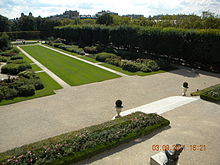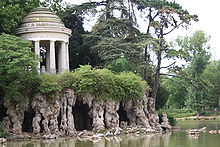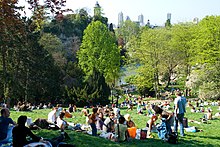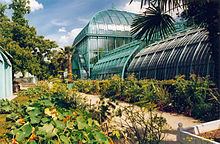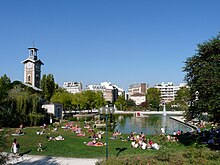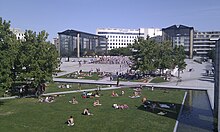History of parks and gardens of Paris
They also featured a long axis perpendicular to the palace, with bodies of water and a view of the whole garden, They were designed to illustrate the Renaissance ideals of measure and proportion, and to remind viewers of the virtues of Ancient Rome.
In 1667, Charles Perrault, the author of Sleeping Beauty and other famous fairy tales, proposed to Louis XIV that the garden be opened at times to public.
She began by planting two thousand elm trees, and commissioned a Florentine gardener, Tommaso Francini, to build the terraces and parterres, and the circular basin the center.
In 1862, during the Second Empire, Georges-Eugène Haussmann replanted and restored the gardens, but also took a portion of the nursery in order to make room for two new streets, Rue Auguste Comte and Place André Honnorat.
It was inspired by the idealized romantic landscapes and the paintings of Hubert Robert, Claude Lorrain and Nicolas Poussin, European ideas about Chinese gardens, and the philosophy of Jean-Jacques Rousseau.
[18] Parc Monceau was established by Phillippe d'Orléans, Duke of Chartres, a cousin of King Louis XVI, wealthy, and active in court politics and society.
"[19] The park contained dozens of fabriques, or constructions, including an Egyptian pyramid, antique sculptures, a Gothic ruin, a Tatar tent, a Dutch windmill, a minaret, a Roman temple, and an enchanted grotto,.
After the Revolution the house and garden became the property of the Papal legate, then of the Russian Ambassador, and then, in 1820, of a religious order, the Dames du Sacré-Coeur-du-Jésus, and served as a boarding school until 1904.
[25] Over the course of seventeen years, Napoleon III, Haussmann and Alphand created 1,835 hectares (7.08 sq mi) of new parks and gardens, and planted more than six hundred thousand trees, the greatest expansion of Paris green space before or since.
The Bois de Boulogne was a scrubby forest to the west of the city, where the German, Russian and British occupation armies had camped after Napoleon's defeat and had cut down most of the older trees.
Belgrand, the hydraulic engineer, built a special conduit from the Ourq canal, dug artesian wells, and laid 66 kilometers of pipes to provide water for the future lakes, lawns and flowerbeds.
The park was completed with the addition of a racetrack, the Hippodrome de Vincennes, in 1863, a public firing range for pistols, rifles, and archery; and the Imperial farm, with orchards, fields, sheep and cows, so the urban residents of Paris could see a real farm at work[28] The Bois de Vincennes was the site of the cycling events of the 1900 Olympics, in a forty-thousand seat stadium built especially for that event.
The Paris zoo was built for the 1931 exposition, and moved in 1934 to its present location in the east of the park, next to a sixty-five meter high man-made mountain, inhabited by alpine goats.
[29] The Parc des Buttes Chaumont, twenty-seven hectares in size in the north of the city, was an unpromising site for a garden; The soil was very poor, and the land bare of vegetation; its original name was "Chauvre-mont" or "bald hill."
It was precisely south of the exact center of Paris- a monument in the park placed by Napoleon I indicated the prime meridian which French maps used until 1911, instead of Greenwich, as the zero degree of longitude.
Parc Montsouris, 15.5 hectares (38 acres) in area, had all the elements of a classical Second Empire garden in a smaller space; a lake, a cascade, winding paths, a cafe, a guignol theater, lawns and flower beds.
It also had a remarkable folly: the Palais de Bardo, a reduced-scale replica of the summer residence of the beys of Tunis, which had originally been part of the Paris Universal Exposition of 1867.
The major Paris architectural and landscape project of the 1930s was the Exposition Internationale des Arts et Techniques dans la Vie Moderne in 1937, on the hill of Chaillot.
The old Palace of Trocadero, which had been used in two previous exhibits, was demolished and replaced by a large terrace with a panoramic view of the Seine and Eiffel Tower, and by the modernist white Palais de Chaillot, with two wings which enveloped the top of the hill.
The upper part, bordered by boulevard Kellermann, is a 1930s combination of classicism and modernism, with a cement portico, two brick excedres decorated with bas-relief sculptures in the 1930s style; a large parterre and basin; and long tree-lined alleys.
Square Andre-Ullmann (1947), in the 17th arrondissement, is one of the typical postwar gardens; symmetrical and austere, it occupies a triangular space, with a pavilion with a rotunda in one corner, two alleys of plane trees, a central green, and bushes and shrubs carved into geometric shapes.
In the 19th century, the site of the Jardin Tino-Rossi, on the quai Saint-Bernard in the 5th arrondissement, had been the place where wine barrels were unloaded from barges for sale at the nearby Halle aux vins.
In 1980, a more ambitious element was added; an outdoor sculpture garden featuring over fifty works by late 20th-century sculptors, including Alexander Calder, Constantin Brâncuși, and Jean Arp.
[43] During the fourteen-year presidency of François Mitterrand, coinciding with the bicentennial of the French Revolution, Paris saw an explosion of major public works projects, including the Opéra Bastille, the Louvre pyramid and underground courtyard, and the new national library.
The Jardin Atlantique in the 15th arrondissement, like the Promenade plantée, has a highly unusual site, perched on twelve concrete pillars seventeen meters above street level, atop the roof over the Gare Montparnasse railway station, which connects Paris with the west of France.
The design of park has a vague resemblance to the deck of an ocean liner, in keeping with the connection of the train station to the Atlantic seaports of Cherbourg and Le Havre.
In 1991, the banks of the Seine were declared a UNESCO cultural heritage site, and efforts began to make the highways and industrial space that remained along the river into a long promenade.
In 2008, during the administration of Mayor Bertrand Delanoë (2001–2014), the city of Paris began to transform portions of the highways built along the left and right banks of the Seine into parks and recreation areas.
The site of the Musée du quai Branly, on the left bank of the Seine, facing the Palais de Chaillot, and just a hundred meters from the EIffel Tower, had been occupied by the buildings of the Ministry of Reconstruction and Urbanism.
The promenade includes five floating "islands", a total of 1800 square meters in size, placed atop barges, with trees, bushes, flowers and deck chairs.





















